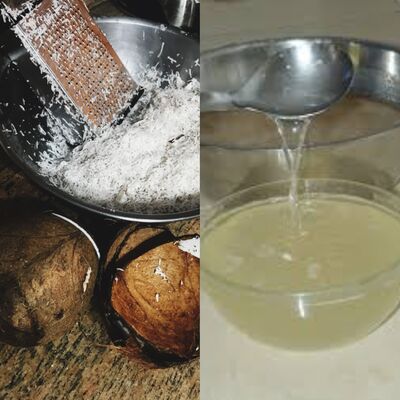
Making your own coconut oil at home is a straightforward and fulfilling process that yields a pure and high-quality product. Whether you intend to use it for cooking, skincare, or haircare, homemade coconut oil is the best option since it contains no additives or preservatives. In this step-by-step guide, you’ll learn how to make coconut oil and discover some useful tips to ensure a successful extraction.
What You’ll Need:
- 3-4 mature coconuts (older ones produce more oil)
- Water
- A blender or food processor
- A fine cheesecloth or strainer
- A large bowl
- A spoon or spatula
Step 1: Preparing the Coconuts
Let’s get started by cracking open the mature coconuts. You can use a hammer or the back of a heavy knife to gently tap the shell until it breaks. Collect the coconut water in a separate container for future use or consumption.
Next, carefully separate the white coconut meat from the shell using a knife or coconut scraper. Rinse the meat with water to remove any residual shell debris.
Step 2: Blending the Coconut Meat
Now, cut the coconut meat into small pieces for easier blending. Place the chunks into a blender or food processor, adding some water to aid in extracting the coconut milk. The recommended ratio is 2 cups of coconut meat to 1 cup of water.
Blend the mixture until the coconut turns into a thick and creamy paste. You may need to pause and scrape down the sides to ensure everything blends smoothly.
Step 3: Extracting the Coconut Milk
To extract the coconut milk, place a fine cheesecloth or strainer over a large bowl and pour the blended coconut mixture into it. Squeeze out as much liquid as possible to extract the coconut milk. Remember, the more liquid you extract, the more oil you’ll obtain later.
Repeat this process with any remaining coconut pieces, making sure you gather every drop of coconut milk.
Step 4: Separating the Oil
Allow the bowl of coconut milk to sit at room temperature for 24 hours. During this time, the oil will naturally separate from the liquid, forming a creamy layer at the top.
After 24 hours, refrigerate the mixture for a few hours until the cream solidifies. Once hardened, scoop out the cream, leaving the water behind. You can discard or repurpose the water.
Step 5: Heating the Cream to Extract the Oil
Now, it’s time to extract the oil from the solidified cream. Place the hardened cream in a pan over low heat. As the cream heats up, it will melt and release the coconut oil. Stir gently, allowing the oil to separate completely from the solids. Keep cooking until all the water evaporates, leaving you with clear coconut oil.
Strain the oil through a fine sieve or cheesecloth to remove any remaining solids.
Step 6: Storing Your Homemade Coconut Oil
Allow the oil to cool before transferring it to an airtight container. Store the oil in a cool, dry place. Homemade coconut oil can last for months without refrigeration, but storing it in the fridge ensures extended freshness.
Benefits of Homemade Coconut Oil
When you make coconut oil at home using this cold-pressed extraction method, you ensure that it retains its natural benefits, such as lauric acid, known for its antimicrobial properties. Making coconut oil at home also means avoiding chemicals and heat processes used in commercial products, guaranteeing a pure and organic outcome.
Why Make Coconut Oil at Home?
- Pure and Unrefined: Homemade coconut oil is free from additives and preservatives.
- Multi-Purpose: Use it for cooking, skincare, and haircare, knowing the quality control is in your hands.
- Cost-Effective: Creating your own coconut oil can save you money in the long run.
- Eco-Friendly: Making coconut oil at home reduces packaging waste and ensures a natural product.
By following this simple method, you can easily create high-quality coconut oil at home. It’s not only a cost-effective and eco-friendly choice but also provides a superior product for various purposes in your daily life. Plus, homemade coconut oil maintains the natural aroma and nutrients of the coconut, delivering a rich and authentic experience.
For more information on how to grow your own coconuts at home, check out this guide on growing a coconut tree from a coconut using the water propagation method or learn the step-by-step process of how to grow and plant a coconut tree at home.




